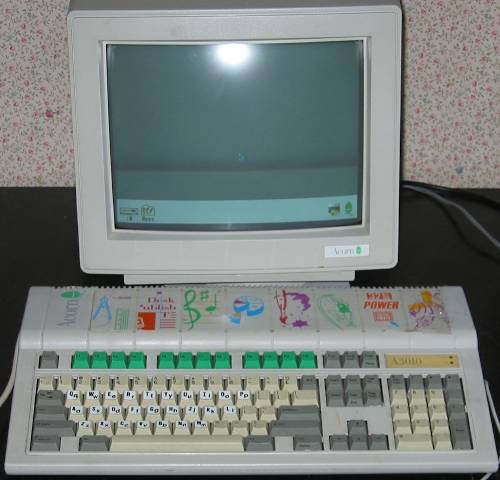
By 1992 the A3000 was getting a bit long in the tooth and in August Acorn announced the replacement computers:
The 3 computers are very similar, being based around the ARM250 which combined the ARM2, MEMC1a, VIDC1a and IOMD chips on a single chip. The new ARM250 ran at 12MHz compared to the A3000's ARM2 which ran at 8MHz
The following models were produced [that I know of]:
Here are the Acorn announcements:
In October 1992 Personal Computer World published a review titles "A3010, A3020 & A4000 ".
Here is the A3010 Welcome Guide.
Here is the A3010, A3020 and A4000 Module Level Service Manual
Here is the A3010, A3020 and A4000 Technical Reference Manual and technical drawings .
The A3010 was launched in Sept 1992, along with the A3020 and A4000, as a replacement for the A3000. The A3010 was nearly twice as fast as the original A3000. The A3010 was aimed at the home market and has a TV modulator, unlike the other Acorn 32 bit computers. There was no provision for a hard disc to be fitted, although that did not stop 3rd parties producing disc interfaces to go in the mini podule slot.
The ARM250 was a complex processor and was delayed as a result Acorn produced a daughter board with the ARM2, MEMC1a and VIDC1a on it which was used in early A3010s. My first A3010 is one of these. These A3010s could be upgraded with an ARM3 processor, the A3010s with the ARM250 could not be upgraded.
I bought my A3010 on ebay in 2001. It has a couple of interesting features, first the "Special Edition" sticker on the top of the case is almost intact (see photographs), second it has the ARM2 MEMC1a andVIDC on a daughter board called "Adelaide", instead of an ARM250. There were production delays with the ARM250 so this was a stop-gap solution. Its product code is ALC15 so once upon a time it was a Learning Curve model, but I have none of the packaging or software that originally came with it.
Here are some pictures:

A3010 running RISC OS 3.11
A3010 running RISC OS 3.11. Note the "special edition" stickers on the top of the case and the slightly unusual green function keys. I think the A3010 was the only Acorn computer to have green function keys.

A3010 right hand side
A3010 right hand side, showing the floppy disc drive. The case is broken and the eject button is missing. However the eject still works if you stick a finger or pen in the hole!

A3010 rear view
A3010 rear view, showing the serial number and the interface ports, from left to right: parallel, serial, joystick, joystick, mouse, headphone, VGA monitor, TV modulator. Above the ports is the panel where a mini podule can be installed. Unlike the A3000 there is no 16 bit podule interface, where a full length podule can be installed, and no Econet socket.

A3010 left hand side
A3010 left hand side showing the reset switch.
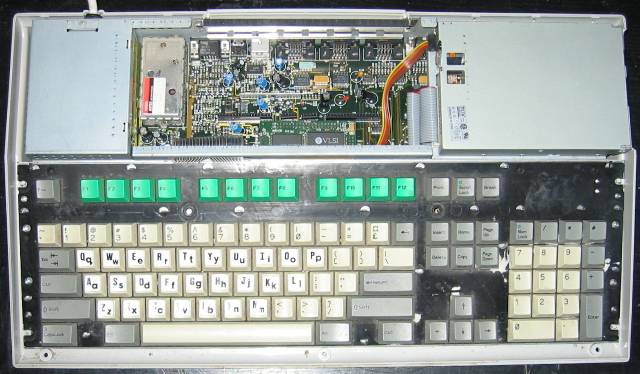
A3010 open
A3010 with the top cover removed, showing the keyboard at the bottom, the power supply in the top left and the floppy disc drive in the top right. In the middle at the top is the panel that is removed when a mini-podule is installed.
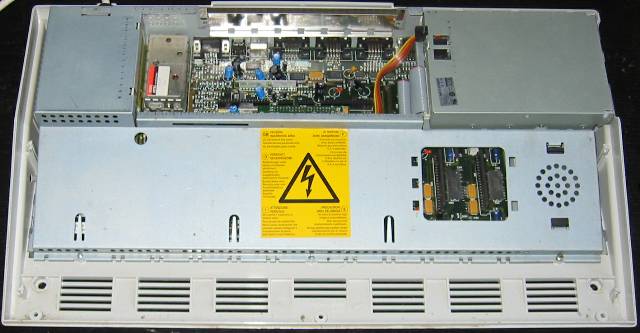
A3010 without keyboard
A3010 with the keyboard removed, showing the metal screening with a hole on the right to access the RAM, there should be a cover but it is missing. This A3010 has had a 1MB upgrade installed.
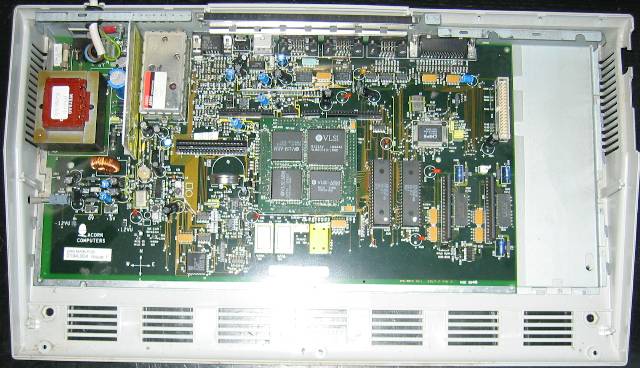
A3010 motherboard
A3010 motherboard, showing the power supply in the top left. In the center is a square daughterboard labelled "Adelaide" with the ARM2 CPU, MEMC1a, VIDC1a and IOMD chips on it. This shows that the A3010 is an early model, because this was replace by the ARM250 chip in later models. The 2 RISCOS 3.11 ROMs are to the right of the daughterboard.
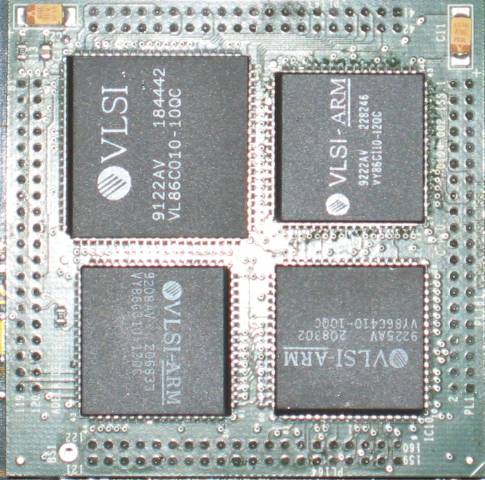
A3010 Adelaide daughter board
A3010 Adelaide daughter board fitted to early A3010s because of production problems which delayed delivery of the ARM250 chip.
I acquired this A3010 in a private sale in 2007. I had looked for An A3010 with the ARM250 chip for some time but not been successful.
Here are some pictures:
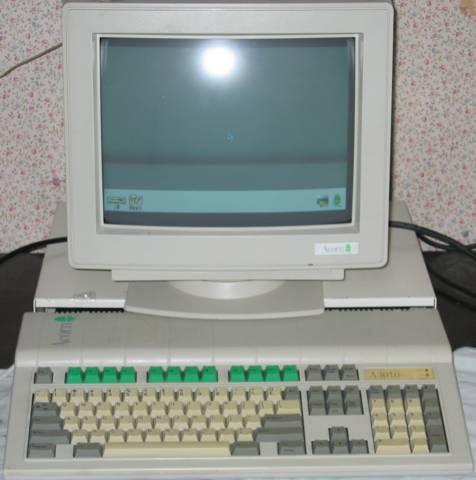
Acorn A3010 running RISC OS 3
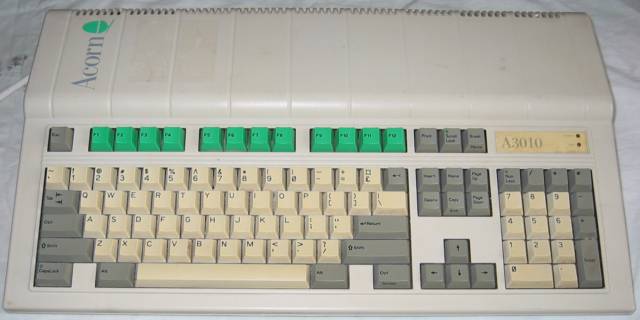
Acorn A3010 (front)
The front of the A3010 showing the green function keys, this is because it was not a BBC Micro.

Acorn A3010 (right side)
This shows the floppy disc with the green eject button.

Acorn A3010 (back)
The back of the A3010 showing the I/O ports, from left to right:
On the left side is the serialnumer and on the right is the power cable and ON/OFF switch. Above the I/O ports is the Expansion card blanking panel.
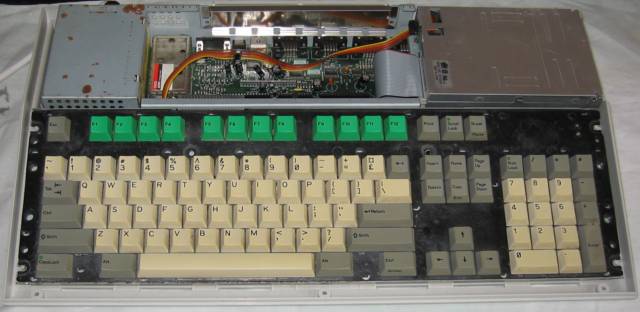
Acorn A3010 with top cover removed
Removing the top cover shows the psu at the left back and the floppy disc drive at the right back.
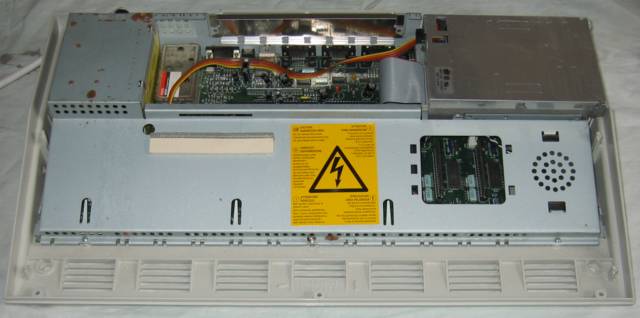
Acorn A3010 with the keyboard removed.
Removing the keyboard shows the loud speaker on the right and the hole in the shielding to allow RAM upgrades, it should have a cover but it is missing.
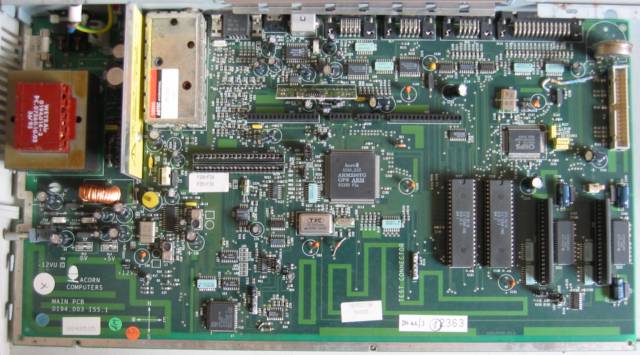
Acorn A3010 motherboard
Removing the RF shielding shows the A3010 motherboard with the ARM250 in the middle. It also shows:
Here is a HiRes picture of the A3010 motherboard .
This A3010 came from a collection of Acorns and software I bought in 2007. It is an AGC40 and has red function keys instead of green function keys. I don't know if it was actually produced with red function keys or if the keyboard was replaced with an A3020 keyboard at some point. The case is the same beige colour as an A3020 rather than the grey of an A3010.
David Holden, of APDL, recently provided this explanation:
Castle purchased a large number of surplus A3010's from Acorn intended for the German market where they didn't sell very well (perhaps 'not at all' would be more accurate). Castle offered these very cheaply as they had a German language version of RISC OS and a German layout keyboard but they didn't have much luck selling them in the UK (for obvious reasons).
To make them 'saleable' Castle substituted UK ROMs and spare UK keyboards intended for the A3020. Hence the red keys. This explains why there's no Acorn warranty. They weren't actually 'sold' by Acorn.
I think the beige floppy drive flap and button is the same as the one normally fitted to the A3020 and this was used by Acorn instead of the usual green eject button on the German model because it didn't have green function keys (they were grey) so the normal A3010 green button would have looked a bit odd.
The A3010 has an ICS ideA version 5 mini-podule and 20MB hard disc installed.

A3010 with red keys
This is an ex-school A3010 (see the security marking on the right back). The label on the right says it is an A3010 but I thought A3010s had green function keys.
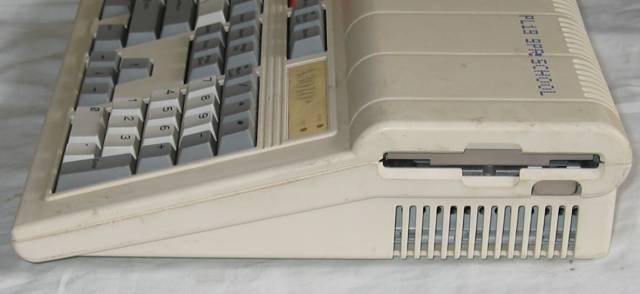
A3010 right side
This shows the floppy disc drive with a grey eject button (normally an A3010 has a green eject button).

A3010 (back)
The back of the A3010 showing the serial number and the I/O ports:
This A3010 has an ICS ideA mini podule installed.
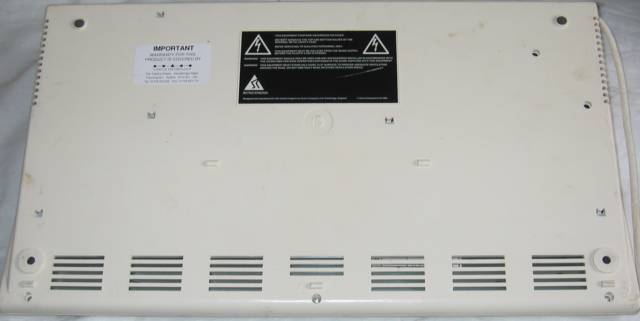
A3010 (bottom)
The white label states "IMPORTANT The warranty for this product is covered by Castle Technology ...". I am not sure if this means that the A3010 was sold by Castle post Acorn.
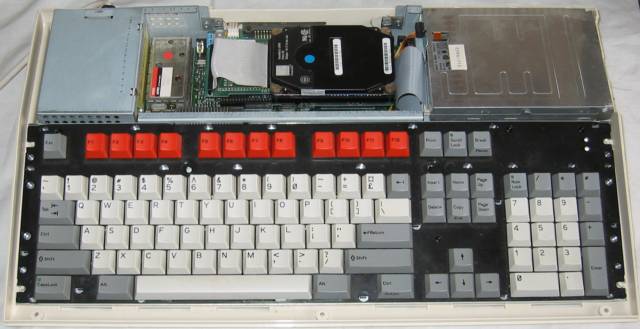
A3010 with the top of the case removed
This picture shows the ICS ideA mini-podule with the 20 MB PrairieTek Prairie 120 hard disc. Note the keyboard part number is 194,011 which is the A3010 keyboard (UK variant).
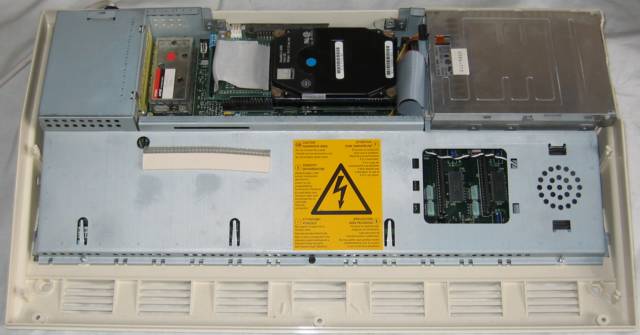
A3010 with keyboard removed
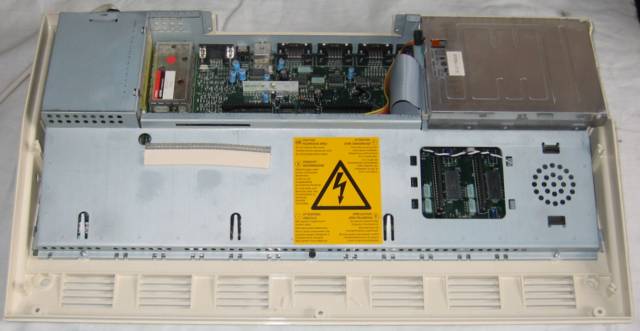
A3010 with ICS ideA mini-podule removed
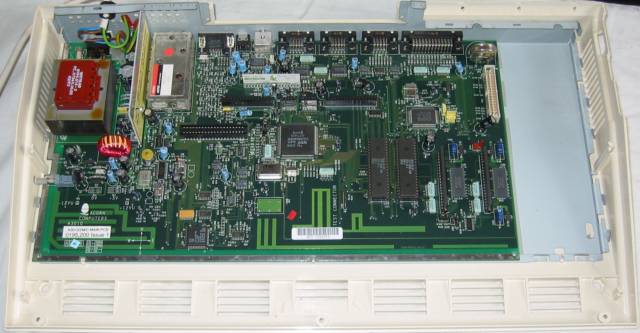
A3010 with top shielding removed
The picture shows the A3010 with the top of the electro-magnetic shielding removed . The PSU is on the left
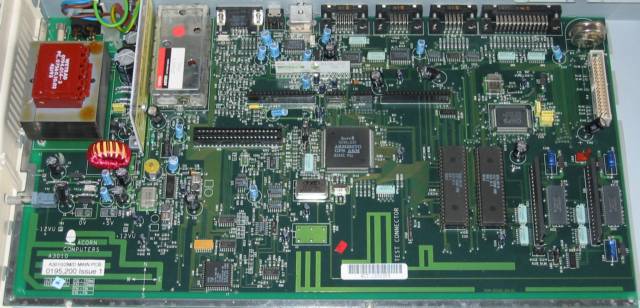
A3010 motherboard
The A3010 motherboard with the ARM250 in the middle. The motherboard labelled "A3010/2M/D Main PCB 0195,500 Issue 1". It also shows:
Here is a HiRes picture of the A3010 motherboard .
Specifications:
| Serial No. | 01-ALC15-0005713 | 01-AGB11-1013830 | 93-AGB40-1010365 |
| Unique Indentity | 0000000DCEA9 | 0000004620BF | 00000024B058 |
| Motherboard part no. | 0194,004 Issue 1 | 0194,003 Issue 1 | 0195,200 Issue 1 |
| Motherboard serial no. | MT-103000909 | 04B535 | WCT1000359 |
| CPU Type | ARM2 | ARM250TG | ARM250TG |
| CPU Model | VL86C010-10QC | 0294,030 | 0294,030 |
| CPU Clock | 12MHz | 12MHz | 12MHz |
| Memory Controller | MEMC1a | ARM250TG | ARM250TG |
| Memory | 2MB | 2MB | 2MB |
| Memory Clock | 12MHz | 12MHz | 12MHz |
| Video Controler | VIDC1a | ARM250TG | ARM250TG |
| Floppy Disc Drive | Citizen OSD | Citizen OSDA-75C | Citizen OSDA-71E |
| Podule 0 | N/A | N/A | ICS ideA version 5 PrairieTek 20MB HD |
| Econet | N/A | N/A | N/A |
| Other upgrades | N/A | N/A | N/A |
| OS | RISC OS 3.11 | RISC OS 3.11 | RISC OS 3.10 |
| OS Date | 29-Sep-92 | 29-Sept-92 | 30-Apr-92 |
| SICK v1.22 Dhrystone/sec kWhetstones/sec | 5508 36 | 5500 35.6 | 5500 35.6 |
| ARMSi v4.0 MIPS | 7.22 | 7.17 | 7.19 |